|
|
|

Robert S. Burnap in 19471 |
Biography
Robert Samuel Burnap was born on 12th July 1894 in the town of Monterey, Massachusetts, USA. He was the son of Irving Arthur Burnap also of Massachusetts, and Annie Binney of Scotland. He married Katherine Worden Decker at East Orange, NJ in 1926.
Burnap graduated from the Massachusetts Institute of Technology (MIT) in 1916, and remained there for an additional year as a research assistant in Illumination and Photometry. This early introduction to lighting paved the way for the start of his career in 1917, when he joined the Edison Lamp Works of the General Electric Company. He was placed in charge of the Physics Laboratory at the lamp works in Harrison NJ.
During World War I he served as a master signal electrician with the Testing Section, Research Laboratory of the Signal Corps. After his military service he returned to the Edison Lamp Works where he was engaged in engineering and lamp design and, in 1924, was appointed Manager of the Commercial Engineering Section. From his patents and publications, it is clear that he had a particular interest in light sources for projection applications. One of his early patents concerned a method for maintaining the dimensional accuracy of projector lamp filaments during their lifetime using a complex arrangement of spring-loaded supports. It is not known whether this was actually employed in production lamps. However his later development of the first pre-focussed lamps was a major breakthrough that came to be widely used across the majority of light sources for projection applications, and was later applied to automotive headlight lamps.
In 1929 lamp manufacturing at Harrison was relocated to other more modern factories, and the site was taken over by another GE subsidiary, the Radiophone Corporation of America. He remained in the same role as manager of Commercial Engineering for RCA, and was active on many professional society and industry standardisation committees. He was a Fellow of the influential SMPTE, the Society of Motion Picture and Television Engineers, and served as its Secretary. A Fellow of the Institution of Electrical Engineers since 1934, he also held the rank of Fellow in the Institute of Radio Engineers (1947) and the American Institute of Electrical Engineers (1951) - the predecessor societies of the present-day IEEE.
As a true pioneer electron tube engineer, he retained the same position at RCA until his retirement in 1959 after 42 years with the company and its predecessors. At that time he was recognised for his outstanding service by the Joint Electron Device Engineering Council, and thereafter served as consultant. He died aged 80 at his home of South Orange, NJ. |
Development of the Pre-focussed Lamp
One of the problems that plagued early photographic and projection lamps was the considerable variation of the filament position with respect to the metal cap, which required a tedious focussing operation by the user each time a new lamp was installed. Burnap's invention was to compensate for the natural variations in manufacturing by inventing the world's first pre-focussed lamp. He developed a 2-part cap, in which a cylindrical metal liner was first cemented to the glass bulb according to standard processes with all its inherent dimensional variations. The secondary outer cap was then accurately placed in a focussing jig, the lamp inserted, and its position varied while viewing an image of the filament in two planes using a special projection microscope. Once the filament had been precisely aligned with respect to the cap, its position was fixed by soldering the cap to the inner metal liner. Pre-focussed lamps could then be installed directly into the projection apparatus without any need for re-alignment.
The cap shell was also re-designed for more accurate positioning in its lampholder. The starting point for this development was the standard 1-inch diameter stamped brass cylinders normally used for the formation of E26 medium screw caps. However the process of rolling the screw threads was omitted, and when cutting the caps out of the brass strip from which they are stamped, a pair of flat metal fins was provided around the open rim. It is the upper surface of these two fins which are the most precisely formed part of the cap, and which form the reference location to which the filament is later aligned. One fin is wider than the other, thereby only allowing the lamp to be installed one way around in its holder. The result is known as the medium pre-focus cap, internationally classified by the International Electrotechnical Commission as type P28s - Prefocus, 28mm maximum fin diameter, single end contact.
The first pre-focus lamps were introduced by GE in 1929 for tubular grid-filament projection lamps, where they quickly revolutionised the industry and practically all new projectors were designed around the new lamps. The following year this development was extended to the larger P40s mogul prefocus size, and applied to spherical-bulb incandescent lamps for spotlighting service which also drew similar benefits from factory pre-alignment. In 1933 a smaller variant of Burnap's pre-focussed cap was applied to automotive headlight lamps. |
References & Bibliography
- "Lamps for a Brighter America", P.W.Keating, McGraw-Hill Book Co., New York, 1954, pp.128, 153.
- "A Century of Light", J.A.Cox, The Benjamin Company, 1979, p.82.
- "Robert S. Burnap - Biography", Journal of the SMPTE, Vol.68, September 1959, p.648.
- "Robert S. Burnap - Obituary", IEEE Spectrum, May 1975, p.90.
|
|
|
|
|